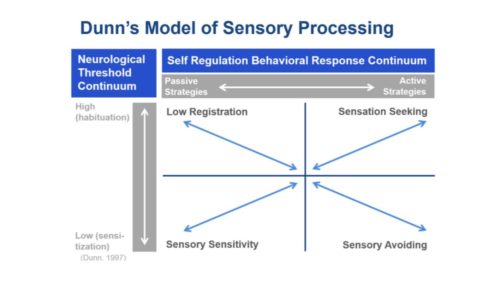
Talk with any parent, therapist, teacher, or other special education professionals about autism, and it won’t take long before sensory seeking behaviors come up in the conversation. As a whole, this entire class of responses can be some of the most intriguing and the most concerning for families. Developing the skills and tools to recognize these behaviors in autism spectrum disorders is one of the first steps in learning how to treat sensory craving behaviors.
What is sensory seeking behavior?
Sensory seeking behavior is a term used to describe a large class of responses that occur to meet a sensory need. Individuals engage in sensory seeking as a way to obtain feedback from the environment. No two sensory seekers demonstrate the same seeking behaviors. Some children and adults with autism have lots of these behaviors—others have only a few or display them only in certain situations.
What causes sensory seeking behavior?

Since the goal of sensory seeking behaviors is to obtain some form of feedback from the environment, they can involve lots of different parts of the body. Sensory issues can be triggered by:
Featured Programs
- sights
- sounds
- smells
- tastes
- textures
- body movements
Some examples include:
- Body movements (e.g., hand-flapping, covering the ears, hair twirling)
- Providing pressure or squeezing to certain parts of the body
- Waving or placing objects near the eyes
- Covering the eyes to avoid bright lights or patterns
- Chewing on objects or clothing
- Avoiding perfumes, lotions, or air fresheners
- Strong aversions to specific food textures
These are just a few examples of sensory seeking, and certainly not an exhaustive list. What’s important to know is that all sensory seeking behaviors have one thing in common. They’re likely to happen regardless of social variables. If given instruction or a social task, a sensory seeking response may occur. But it may also happen without others present at all.
Dunn’s Model of Sensory Processing

One of the most well-known models of sensory processing is Dunn’s Four Quadrant Model of Sensory Processing. The model is based on neurological thresholds and behavioral responses. Individuals have a neurological threshold to sensory stimuli that falls on a continuum from low to high. Sensory seekers with a high neurological threshold may not be responsive to typical levels of sensory input and may miss stimuli. Those with a low neurological threshold have a system that is easily activated by sensory stimuli and are quick to respond.
Likewise, behavioral response also exists on a continuum from active to passive. Individuals with passive tendencies may not act to change their environment (despite having an internal response). Those on the active end may try to control aspects of the sensory input they are exposed to. Of course, the behavioral response can be different depending on the type of sensory input.
These constructs make up the quadrants of Dunn’s Four Quadrant Model of Sensory Processing.
How are sensory seeking and autism related?

Many people wonder why sensory seeking behavior and autism seem to go hand-in-hand. Since 2013, to receive a diagnosis of Autism Spectrum Disorder from a medical professional, an individual must demonstrate persistent repetitive or ritualistic behaviors. Often, these behaviors come in the form of sensory seeking responses. While it’s not required for all individuals with autism to be sensory seekers, many do at different points in time.
What about Sensory Processing Disorder?

As you encounter research and advice on treating sensory seeking behaviors at home, you may also read about Sensory Processing Disorder. While not an official diagnosis made by psychiatrists, psychologists, and other medical professionals, SPD describes problem behavior and difficulties with over-sensitivity to some environmental stimuli and under-sensitivity to others. Many parents of sensory seekers believe that it relates to their child’s inability to respond appropriately to sensory stimulation in the environment. Many of these children also have autism or other developmental disorders. If you suspect that your child may have autism or sensory processing issues, consult a professional for an evaluation and diagnosis.
Are sensory seeking behaviors ‘bad’ or need to be treated?

One of the growing debates in the Autism and Sensory Processing Disorder communities revolves around sensory seeking behaviors and whether they should or should not address them. Some advocates believe these behaviors help the sensory seeker express themselves or meet their needs in the environment. Others believe these seeking behaviors are harmful, especially when they interfere with learning or socializing with friends. Concerns also arise when this behavior becomes dangerous, like in the case of self-injury or pica.
Featured Programs
Like most things related to autism, there’s a spectrum of different answers to the question of whether to intervene with these behaviors. In most cases, individualizing the decision to treat sensory craving at home, a clinic, or in school leads to better outcomes. The decision should account for:
- individual preferences
- the severity of the behavior
- the values of a family
Treating Sensory Seeking Behaviors At Home

If you evaluate that your child’s seeking behaviors are creating barriers to learning and may need intervention, below are some steps to help you assess the best way to respond:
- Step One: Observe your child. The first step in addressing these behaviors at home is to observe a child’s behaviors. Having a firm understanding of when the sensory-seeking responses are likely to occur along with triggers and supports can help better develop a sensory-seeking behavior plan. Before beginning to treat sensory seeking, parents should be able to answer questions like:
- When does my child engage in sensory-seeking behavior?
- Do my child’s actions function to seeking out sensory feedback or to stop some form of sensory input from happening?
- Step Two: Determine a goal. Children on the autism spectrum engage in a variety of different profiles of sensory seeking behavior. Because no two children are the same, every goal about treating these behaviors at home should adapt to that child and family’s needs. After observing your child, set a goal about how you’d like to change your child’s behaviors. Depending on factors like safety, disruption to others, disruption to learning new skills, and your family’s values, you may decide sensory seeking can occur:
- in a more appropriate form
- at some times but not others
- not at all
- Step Three: Decide on an intervention. If you’ve determined that your child is seeking sensory input which requires intervention, there are several options for addressing the behavior. Some of these include:
- Make environmental accommodations. If something as simple as turning down music or dimming lights helps reduce the trigger for your sensory seeker, it’s a better solution than a complex intervention.
- Try a sensory diet or provide regular access to sensory seeking activities in a safer or more appropriate form.
- Give access to sensory activities after learning activities in a ‘first…then…” format.
- Teach your child to ask for sensory needs rather than use inappropriate behavior.
- Use a visual schedule to help a child understand when sensory input is available.
- For aversive situations that can’t be changed, practice in small, gradual steps working up to tolerating more of the sensory input.
- Step Four: Evaluate and adjust. Many parents of sensory seekers find that sensory craving behaviors change over time, sometimes rapidly. Just as a goal and intervention are successful, a new response appears, or the behavior shifts to a slightly different form. These ongoing changes require parents to continue to observe their child’s behavior and adjust dynamically.
Activities to support a sensory seeking child
A sensory seeking toddler or young child will certainly keep you on your toes! Here are some sensory seeking activities to keep them active while they engage in sensory exploration.
Tunnel Play
Tunnel play is a well rounded activity that creates vestibular and proprioceptive input through:
- crawling
- balance
- rolling
Children can also improve fine motor and gross motor skills. The tunnel can be used to encourage a sensory seeking toddler to move items from one end to the other. They can also lay in it while an adult rolls them back and forth gently for additional sensory stimulation.
Finger Painting
The great thing about finger painting is that “paint” can be just about anything! Sand, rice, pudding…the options are endless. Depending on the needs of your sensory seeker, you could add a smell or taste component.
Conclusion
Finally, while many families find success in treating sensory craving behaviors at home, others may need professional support. Children seeking sensory input are uniquely complex. The assistance of a skilled professional (like an occupational therapist) with experience in sensory-related interventions can help provide your child with sensory processing difficulties have the best possible outcomes.
Amy Sippl
Applied Behavior Analysis | Saint Cloud State University
Bachelor of Arts (B.A.), Psychology | University of Minnesota
More Articles of Interest: